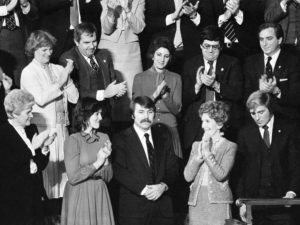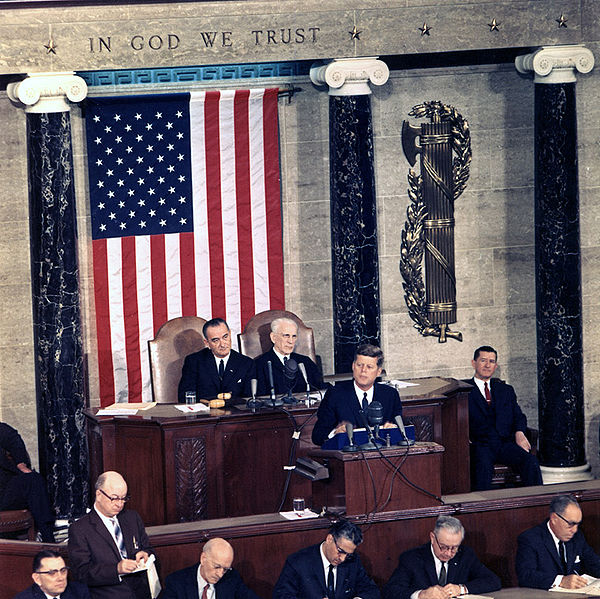On February 28th, President Trump will address a joint session of Congress, as is tradition for incoming presidents in their first year in office. This major address is similar in purpose to the State of the Union, which is given by the president annually in subsequent years of his term. What is important about this speech and why should you watch?
Roots in the Constitution
The State of the Union speech finds its roots in the U.S. Constitution and is considered an important part of our system of checks and balances. The U.S. House of Representatives website explains:
“The Constitution states that the President will ‘give to the Congress Information of the State of the Union, and recommend to their Consideration such Measures as he shall judge necessary and expedient’ (Article II, section 3)… ”
This event is steeped in ceremony and tradition, with the Speaker of the House and the Vice President sitting on the dais and the Speaker presiding over the ceremony.
History of the Joint Session of Congress Addresses
In our government’s early years, some presidents fulfilled this obligation by sending a written message to be read aloud in the House and Senate. President Jefferson “was concerned that the practice of appearing before the representatives of the people was too similar to the British monarch’s practice of addressing each new Parliament with a list of policy mandates, rather than ‘recommendations.” (Learn more about the history of how the State of the Union was presented to Congress.)
In 1913 President Wilson resumed the tradition of delivering the speech in person. Recent Technological changes have allowed the President to speak directly to the American people.
Who Attends — and who doesn’t?

AP photo
The Supreme Court Justices, members of Congress, Senators, and the president’s cabinet are all invited to attend the speech, held in the House chamber. At each State of the Union address, one Cabinet member is appointed the “designated survivor,” to watch it from a distant location “in order to maintain the continuity of government should a ‘calamity’ happen while all other members of the federal government are in a single location.”
President Ronald Reagan began a tradition of highlighting ordinary Americans that had accomplished the extraordinary and “asked (these) guests to join the First Lady in the gallery. These individuals usually have performed an act of heroism or achieved an impressive milestone that illustrates an important theme in the President’s speech.”
What’s Covered in these speeches and how long do they last?
The archives of the House of Representatives notes that the “message content” changed over time from a lengthy administrative report in the 19th century, to a platform for the President to rally support for his agenda. The American Presidency Project has tracked the length of many modern Addresses: President Clinton gave some of the longest speeches, but President Obama was not far behind.
Significant past Joint Session Addresses and State of the Unions
Perhaps one of the most historically significant and memorable addresses in recent memory was George W. Bush’s famous post-September 11th address to a joint session of Congress and the nation, which identified al Qaeda terrorists as the perpetrators of the attack, characterized the group as “enemies of freedom” and initiated the War on Terror.
President Franklin Roosevelt’s 1944 State of the Union wartime address to Congress was also momentous, reminding Americans why they were involved in the war and how each American played an important part:
“I have often said that there are no two fronts for America in this war. There is only one front. There is one line of unity which extends from the hearts of the people at home to the men of our attacking forces in our farthest outposts. When we speak of our total effort, we speak of the factory and the field, and the mine as well as of the battleground — we speak of the soldier and the civilian, the citizen and his Government.”
Why tune in next week and watch?
Speaker Ryan has said of next week’s address that “this will be an opportunity for the people and their representatives to hear directly from our new president about his vision and our shared agenda. This is an ambitious agenda and rightly so. ”
Peggy Noonan noted that President Reagan was disciplined with his messaging suggesting “(Mr Trump’s team at the White House) need systems, order, process, calm. They need clear lines of authority and responsibility.” Under Reagan “ the first year (was) devoted to a single issue, the economy, starting with tax cuts. If you turn the economy around, the president thought, everything else becomes possible.”
Will President Trump use this speech to highlight one or two key goals for 2017? Tune in to listen to the State of The Union on February 28 and find out.
It’s a movement!
Recommend a Circle Leader. Especially in Nebraska, Wisconsin, Minnesota and Missouri where circles are sprouting.
Start a Circle in your neighborhood. Add value in your community by giving women the facts and the space to strengthen their understanding of the issues.
Invest in The Policy Circle. Together let’s build a network of women who want to assume their civic duties and understand the impact of policy in their lives.
The Policy Circle is a 501(c)3 that provides a fact-based, nonpartisan framework that inspires women living in the same community to connect, learn about and discuss public policies that impact their lives. Women across the nation are taking a leadership role in public policy dialogue on what human creativity can accomplish in a free market economy.
